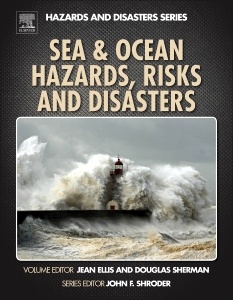Coastal and Marine Hazards, Risks, and Disasters
Coordonnateurs : Ellis Jean, Sherman Douglas J.
Rédacteur en Chef : Shroder John F.

Sea and Ocean Hazards, Risks and Disasters provides a scientific approach to those hazards and disasters related to the Earth's coasts and oceans. This is the first book to integrate scientific, social, and economic issues related to disasters such as hazard identification, risk analysis, and planning, relevant hazard process mechanics, discussions of preparedness, response, and recovery, and the economics of loss and remediation. Throughout the book cases studies are presented of historically relevant hazards and disasters as well as the many recent catastrophes.
1. Introduction to coastal and marine hazards and disasters 2. Generation, characteristics, and dynamics of tsunami 3. Paleo-tsunami4. Tsunami warning and mitigation5. Tsunami case studies6. Generation, characteristics, dynamics, and modeling storm surge7. Paleo-storm surge8. Storm surge warning and mitigation9. Storm surge case studies10. Sea level rise scenarios and causes11. Adapting to sea level rise12. Mitigating coastal change13. Shoreline change case studies14. Extreme waves 15. Rip currents/undertow16. Sea ice17. Threats to mangrove resources and mitigation 18. Threats to coral resources and mitigation19. Threats to marsh resources and mitigation20. HABs
Ocean, coastal, and atmospheric scientists; geologists and hydrologists
- Contains contributions from experts in the field selected by a world-renowned editorial board
- Cutting-edge discussion of natural hazard topics that affect the lives and livelihoods of millions of humans worldwide
- Numerous full-color tables, GIS maps, diagrams, illustrations, and photographs of hazardous processes in action will be included
Date de parution : 10-2018
Ouvrage de 592 p.
15x22.8 cm
Ancienne édition
Accéder à la nouvelle édition.
Date de parution : 11-2014
Ouvrage de 592 p.
15x22.8 cm
Ancienne édition
Accéder à la nouvelle édition.
Thèmes de Coastal and Marine Hazards, Risks, and Disasters :
Mots-clés :
Accommodation; Adaptation; Baltic Sea; Barrier; Barrier-island morphology; Beach drowning; Beach morphology; Beach safety; Biophysical hazards; Boulder transport; Climate change; Coastal defense measures; Coastal flooding; Coastal hazard; Coastal megacities; Coastal processes with sea levels; Coastal vulnerability and management; Coasts; Coral reefs; Cumulative impacts; Delta Works; Disaster risk reduction; Early warning system; Earthquake; Ecomorphodynamics; Environmental change; Eustasy; Extreme events; Extreme waves; Forecasting; Forest density; Future and impacts; Geophysical hazards; Geophysical risk; Hamburg; Hazards; Impact; Implications for disasters; Inundation; Inundation extent; Invasive species; Islands; Isostasy and Earth crustal changes; Land use; Landslide; Mangrove loss; Mangrove restoration; Meteotsunami; Mitigation; Natural coastal protection; Nearshore circulation; Numerical modeling; Paleotsunami; Past; Phase shift; Pollution; Prediction; Prehistoric tropical cyclones; Present; Protection; Qingdao; Reef resilience; Retreat; Ridge and runnel; Rip currents; Risks; Runup; S; Salt marsh; Sea ice; Sea level rise; Sea-level and sea surface changes; Sea-level definitions and measurement; Storm deposits; Storm impact; Storm recovery; Storm surge; Storm-derived; Surf-zone currents; Thames Barrier; torm surge; Tropical cyclone; Tropical cyclones; Tsunami; Tsunami extent; Tsunami impacts; Tsunamigenic processes; Tsunamigenic source; Tsunamograph; Typhoon Haiyan; US National Hurricane Center SLOSH model; Vegetation roughness; Volcano; Vulnerability; Water level recording; Wave energy dissipation; Wave run-up; Wave set-up; Wave transport capability



